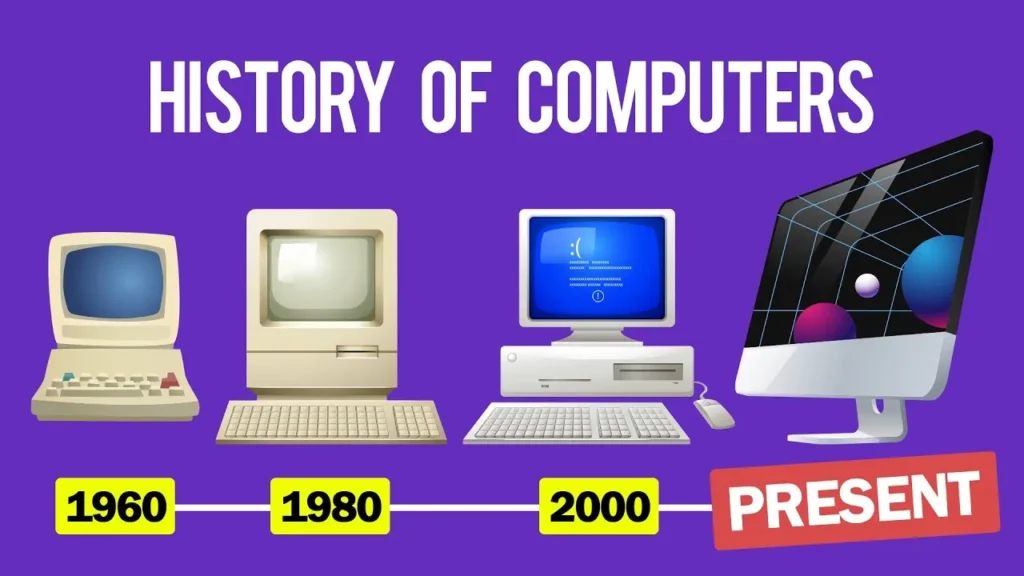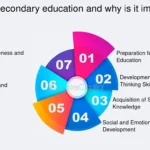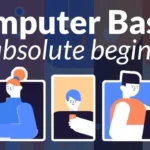What is a computer and its history?
What is a computer and its history? A computer is an electronic machine that is used to process data and carry out operations according to instructions provided by a user or a program. Apart from software making it possible to carry out a series of tasks, it functions through hardware components like the CPU, RAM, and storage. Computers are used in almost all areas, from commerce and education to entertainment and research. What is a computer and its history?
Major parts of a computer:
The brain of the computer that handles instructions is the central processing unit (CPU).
- RAM, or temporary memory with fast access to data
- Both hard disks and SSDs permanently store data.
- Keyboard, mouse, scanner, touchscreen, microphone, and other devices are utilized for data entry.
- Monitor, printer, speakers, and projectors that display or produce outputs.
- Operating systems and software that manage hardware operations are software.
- Internet and data communication are enabled by routers, modems, and network cards.
The Evolution of Computers
1. Early Instruments for Computers
People utilized basic calculators such as the abacus (invented in 2000 BC), Napier’s Bones, and mechanical calculators such as the Pascaline (invented by Blaise Pascal) and the Analytical Engine (built by Charles Babbage in the 19th century) before modern computers. Originally the first computer programmer, Ada Lovelace wrote the Analytical Engine’s algorithms.
Second Generation (1940–1956): Vacuum Tubes
There was use of vacuum tubes to process the early electronic computers like UNIVAC (Universal Automatic Computer) and ENIAC (Electronic Numerical Integrator and Computer). These bulky, costly devices needed sophisticated cooling systems. Programming involved the use of punched cards and machine language.
Third generation (1956–1963): transistor
Smaller, faster, more energy-conserving computers were the outcome of the transistor replacement of vacuum tubes. High-level programming languages COBOL and FORTRAN, which enabled programming with greater ease, emerged during this generation.
Fourth Generation (1964–1971: Integrated Circuits)
Integrated circuits (ICs) enabled many transistors to be included on a single chip, thereby making computers smaller, less expensive, and more powerful. Operating systems and time-sharing features also emerged during this period, which greatly increased access to computers for businesses and researchers.
5. Fourth Generation: Microprocessors, 1971–Present
Packaging thousands of transistors onto a single chip, microprocessors changed computing. Then came PCs. New leaders in the computer field were firms such as Apple, Microsoft, and IBM. Further increasing the use of computers were the invention of graphical user interfaces (GUIs), the internet, and mobile computing.
Sixth Generation (Current and Future: Artificial Intelligence and Quantum Computing)
Computers today carry out demanding tasks with today’s networking, cloud computing, and artificial intelligence. With quantum bits (qubits), researchers are working on quantum computing—which would process information much more quickly than conventional computers. Part of this generation are also developments in autonomous systems, neural networks, and robotics.
Computers’ Role in Modern Life
- Education: e-learning platforms, virtual libraries, and research databases.
- Business: E-commerce, automation, data analytics, and digital marketing.
- Healthcare: Robotic surgery, patient records, artificial intelligence-based diagnostics, medical imaging.
- Entertainment included video games, streaming online, digital artwork, and virtual reality.
- Emails, video conferencing, social networking, and instant messaging.
- Big data analysis, artificial intelligence applications, and simulations are all appropriate for science and research.
- Security and defensive: Smart defensive systems, encryption, surveillance, and cybercrime.
Computers’ Future
- With smart technologies, the future of computers will be focused on increasing speed, reducing power usage, and integrating more into everyday life. Some of the future developments are:
- Computational power much beyond today’s supercomputers in quantum computers.
- Artificial intelligence: human-like decision-making machines.
- The direct communication between the human brain and computers is referred to as brain-computer interfaces (BCI).
- Sophisticated visual presentation without actual screens is achieved by holographic displays.
- Self-driving cars, robots enabled by AI, and factory automation are all autonomous systems.
Frequently asked questions (FAQs)
1. Who invented the first computer?
Charles Babbage devised the first mechanical computer in the 19th century. In 1945, John Presper Eckert and John Mauchly created ENIAC, the first electronic computer.
2. What was the first personal computer?
The Altair 8800, released in 1975, is a personal computer. Later, IBM and Apple, with their models, popularized personal computing.
3. During what time span have computers evolved?
From massive, room-sized computers, they have developed into small but powerful machines with artificial intelligence, mobile computing, and cloud storage.
4. Unlike hardware and software, what is the difference between them?
While software is made up of operating systems and programs that dictate the hardware, hardware is the physical component of a computer.
5. Computers’ future is what?
Quantum computing, higher levels of automation, and AI-driven systems will all play a part in future computer capacity increases.
6. Information processing on computers: What is a computer and its history?
It is with the CPU that the computer interprets and carries out instructions that are in memory.
7. In what way does cloud computing fit contemporary technologies?
Providing scalability, affordability, and improved collaboration, cloud computing enables users to store and retrieve data remotely via the internet.



